Greetings science-loving friends, do you know what the photosynthetic organ par excellence of the plant is? If you answered the leaf you are right, normally this organ is flattened and comes from a fundamental tissue called: (apical cauline), the phenomenon of photosynthesis occurs thanks to the large accumulation of chloroplasts that we see in the leaf, not to mention that without the leaf the plants would lose water, so they control transpiration. This experiment is to make some cuts of woody and herbaceous leaves to study how the tissues work, enjoy the experience.🥬🔬
Saludos amigos amantes de la ciencias, sabes cual es el organo por excelencia fotosintetico de la planta? si respondiste la hoja estas en lo cierto, normalmente este organo es en forma aplanada y viene de un tejido fundamental llamado: (caulinar apical), el fenomeno de la fotosintesis ocurre gracia a la gran acumulacion de cloroplastos que vemos en la hoja, sin mencionar que sin la hoja las plantas perderian agua, asi que controlan la transpiracion. Este experimento es para realizar algunos cortes de hojas lenosas y herbaceas para estudiar como funciona los tejidos, disfruta la experiencia.🧑🏻🎓🧪🧫
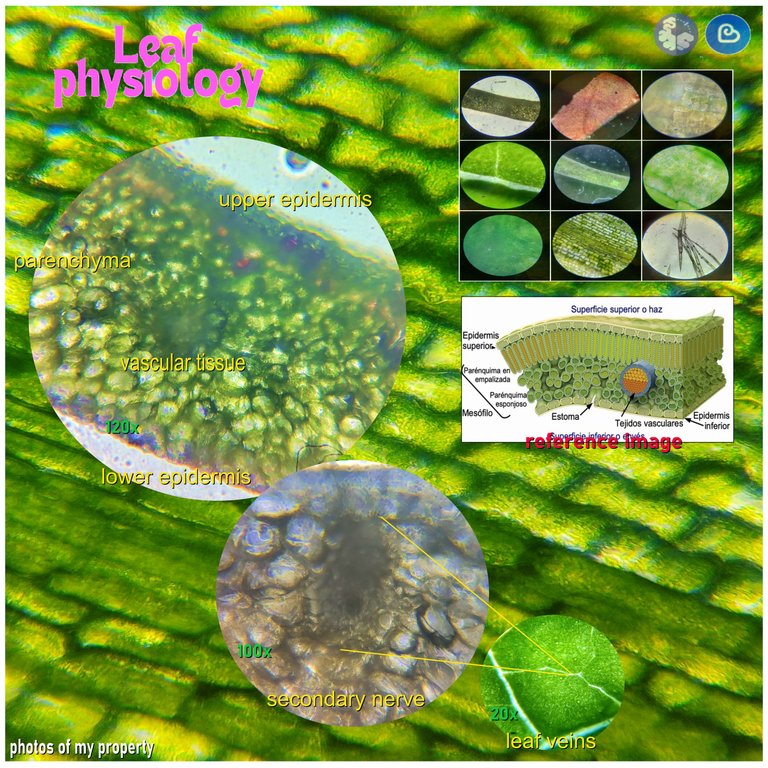
Leaf Veins🧫🧪🔬/Nervios de las hojas🥬🧑🏻🎓
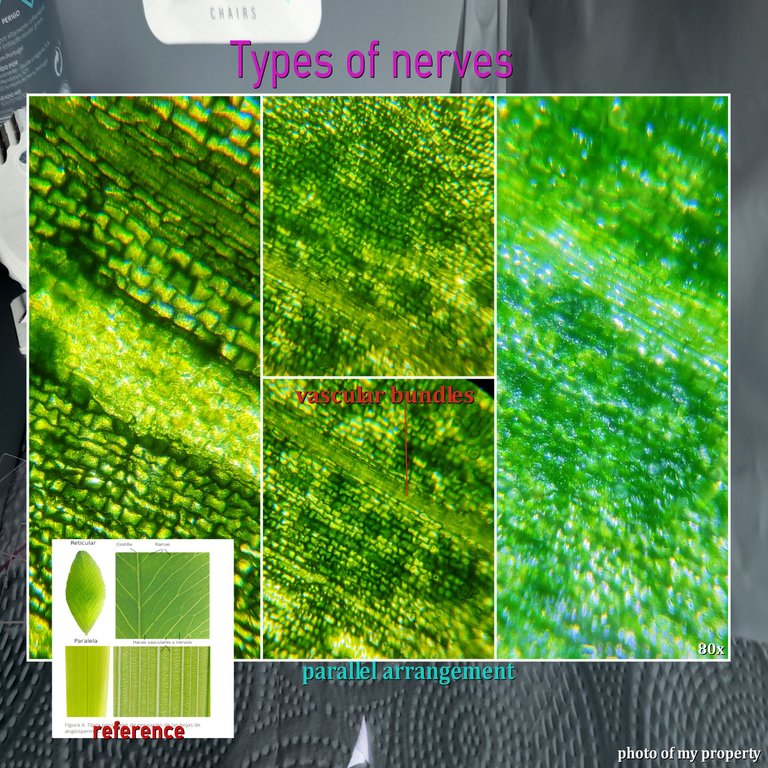
All leaves have a conduction system for both liquid and solid substances, this conduction and transport system within the leaf is called: (nerves) and are those lines that we see throughout the leaf with varied sizes and arrangement, in order to carry out photosynthesis in the leaf different components are needed which are transported by the root, stem and finally reach the photosynthetic cells where the chloroplasts play a crucial role. Clearly like the stem here the xylem and phloem are part of the nerves in the stem were the (conductive bundles), as you can see the distribution pattern of the nerves can be: (reticular if it does not have a pattern and parallel if they comply with a pattern, there are other types of venation! The venation in the leaves has a pattern (main, secondary, tertiary) and depends on the level of thickness that the nerve has.🧑🏻🎓🥬🧫
Todas las hojas poseen un sistema de conduccion tanto de sustancias liquidas como solidas, ese sistema de conduccion y trasnporte dentro de la hoja se denomina: (nervios) y son esas lineas que vemos en toda la hoja con tamanos y disposicion variada, para poder realizar la fotosintesis en la hoja se necesita diferentes componentes los cuales se transportan por la raiz, tallo y finalmente llegan a las celulas fotosinteticas donde los cloroplastos hacen un papel crucial. Claramente al igual que el tallo aqui el xilema y el floema forman parte de los nervios en el tallo era los (haces conductores), como puedes ver el patron de distribucion de los nervios puede ser: (reticular si no tiene un patron y paralelo si cumplen con un patron, existen otros tipos de nerviacion!. La nerviacion en las hojas tiene un patron (principal, secundarios, terciarios) y dependen del nivel de grosura que tiene el nervio.🌷🧪
https://mmegias.webs.uvigo.es/2-organos-v/guiada_o_v_hoja.php

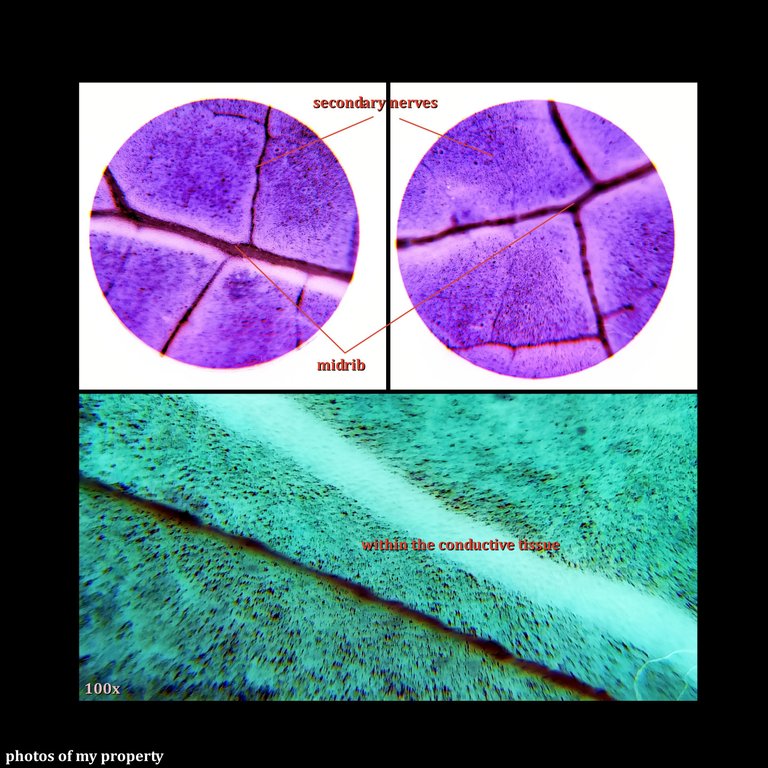
The main and secondary nerves will always be considered as the main ones since their irrigation and transport rate exceeds any other nerve, by the way the vascular bundle also appears here since it is the name of the perivascular parenchyma, in some species of plants in the vascular bundle we can see sclerenchyma and collenchyma, the smaller nerves from order 3 to 6 are more destined to collect the products generated in the mesophyll, and normally they are not distributed throughout the leaf ending in "blind spots". But why do you have chlorenchyma and sclerenchyma in a leaf? Well, to help support the plant like the parenchymous medulla does in the stem.🥬🧑🏻🎓🔬
Los nervios principales y secundarios siempre seran considerados como los principales ya que su tasa de irrigacion y transporte supera a cualquier otro nervio, por cierto aqui tambien figura el haz vascular ya que es el nombre del parenquima perivascular, en algunas especies de plantas en el haz vascular podemos ver esclerenquima y colenquima, los nervios mas pequenos del orden 3 al 6 son mas destinados a recoger los productos generados en el mesofilo, y normalmente no se distribuyen en toda la hoja acabando en "puntos ciegos". Pero para que tienes clorenquima y esclerenquima en una hoja? pues para ayudar con el soporte de la planta como hace la medula parenquimosa en el tallo.🧪🧫
https://brainly.lat/tarea/45462975

Leaf Veins🧫🧪🔬/Nervios de las hojas🥬🧑🏻🎓
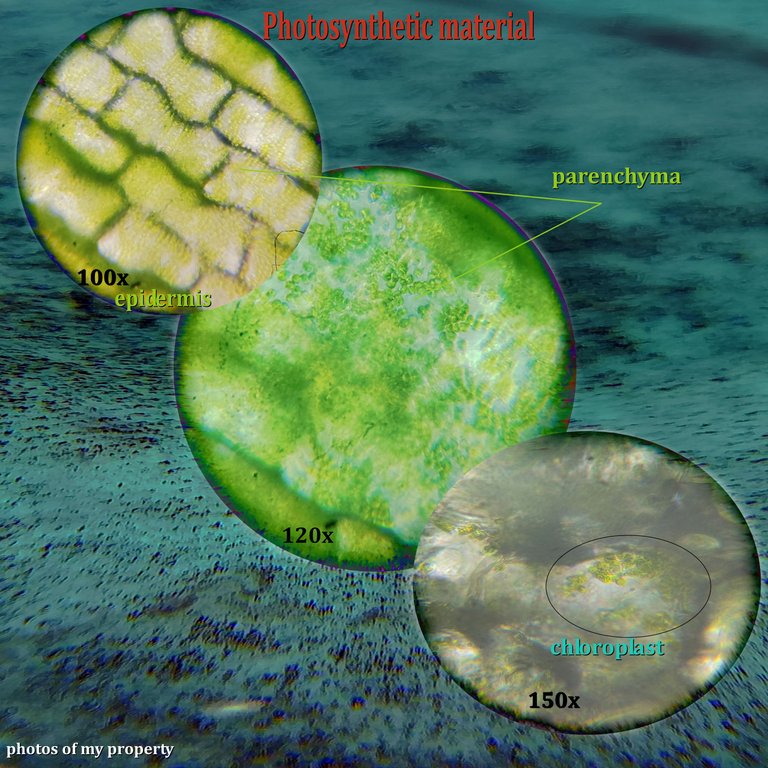
Do we get chloroplasts in the epidermis? Well no, and we notice the coloration, the epidermis is a very thin layer that is transparent under the magnifying glass that serves as a barrier to water loss or entry into the leaf and protection against pathogens, but we can get some stomata, to understand photosynthesis we would have to advance one layer further into the leaf to the (mesophyll), the mesophyll is a thick layer that we get between the two layers of epidermis (adaxial, abaxial), just like other tissue is parenchymatic type tissue, and we are going to highlight the palisade parenchymatic tissue where a large number of chloroplasts are located, how do we recognize this parenchyma? Well, its cells are elongated and packed full of chloroplasts under high magnification. There is also in the mesophyll the lacunar parenchyma more towards the abaxial part.🔬🧑🏻🎓
Conseguimos cloroplastos en la epidermis? pues no, y si notamos la coloracion la epidermis es una capa muy fina transparente bajo la lupa que sirve como una barrera para la perdida de agua o entrada en la hoja y proteccion contra patogenos, pero si podemos conseguir algunos estomas, para comprender la fotosintesis tendriamos que avanzar una capa mas adentro de la hoja al (mesofilo), el mesofilo es una gruesa capa que la conseguimos entre las dos capas de epidermis (adaxial,abaxial), al igual como otro tejido es tejido de tipo parenquimatico, y vamos a destacar el tejido parenquimatico de empalizada donde se situan una gran cantidad de cloroplastos, como reconocemos este parenquima? pues son alargadas sus celulas y empaquetadas llenas de cloroplastos con un gran aumento. Tambien existe en el mesofilo el parenquima lagunar mas hacia la parte abaxial.🥬🧪
https://mmegias.webs.uvigo.es/2-organos-v/guiada_o_v_hoja.php

More about the main nerve🧫🧪🔬/NMas sobre el nervio principal🥬🧑🏻🎓
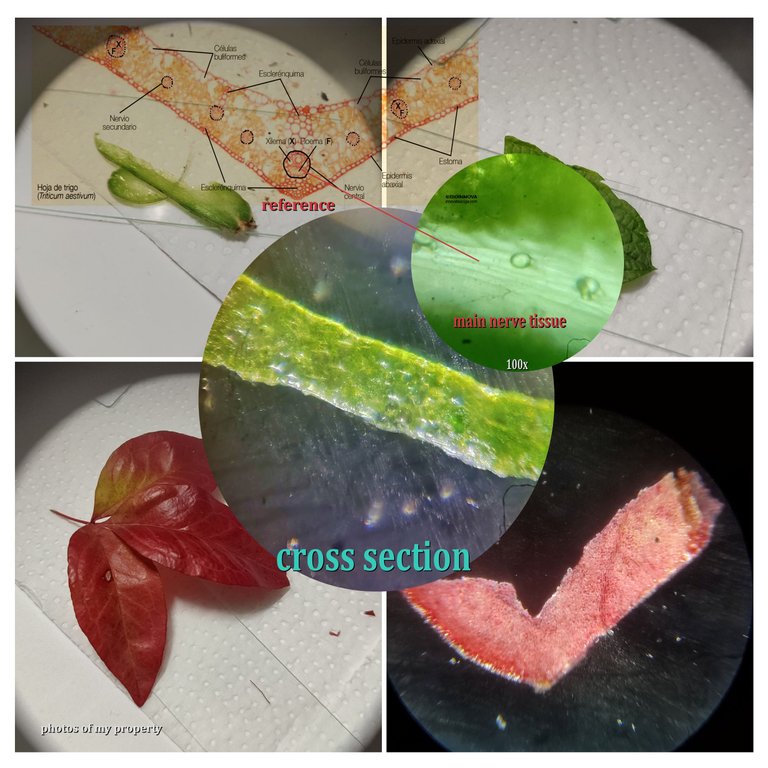
There are two types of photosynthesis C3 and C4 being C4 a more efficient type of photosynthesis, the vascular bundle in both types of plants have a very noticeable differentiation within their tissues, the C4 can have two layers of concentrated mesophyll and around the bundle a parenchyma full of chloroplasts in our case we do not see that arrangement that is why we refer to a type C3 plant, the nerves in the C4 have almost no separation.
Existen dos tipos de fotosintesis C3 y C4 siendo la C4 un tipo de fotosintesis mas eficiente, el haz vascular en ambas tipos de planta tienen una diferenciacion muy notoria dentro de sus tejidos, las c4 pueden tener dos capas de mesofilo concentrado y alrededor del haz un parenquima lleno de cloroplastos en nuestro caso no vemos esa disposicion por eso nos referimos a una planta de tipo C3, los nervios en las C4 casi no tienen separacio.
https://mmegias.webs.uvigo.es/2-organos-v/guiada_o_v_hoja.php

Palisade parenchyma🧫🧪🔬/Parenquima de empalizada🥬🧑🏻🎓
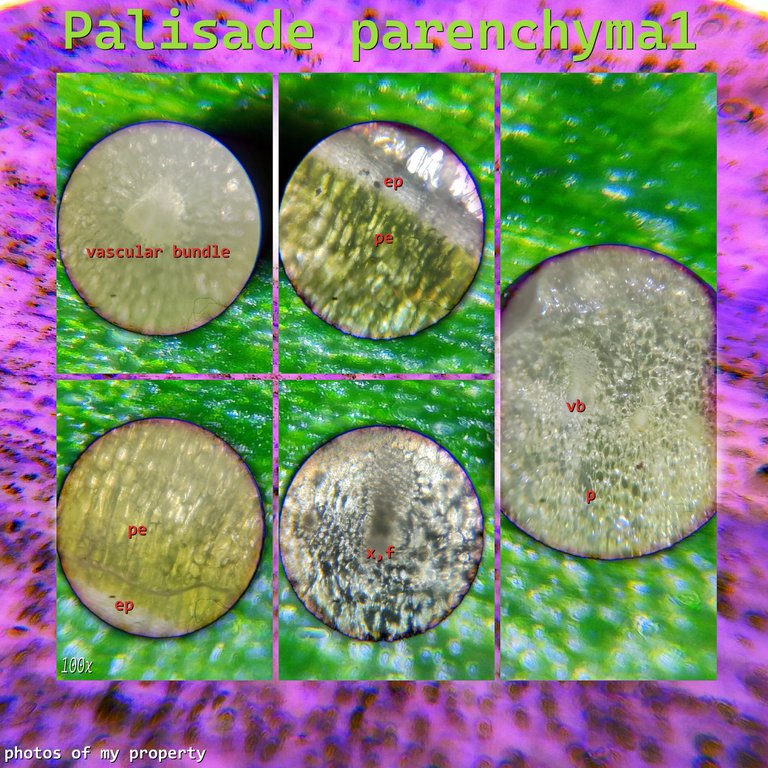
Chlorophyll parenchyma is also called mesophyll, there are two ways in which the cells are arranged in the mesophyll, very close together (palisade) or with spaces (lacunar), the palisade cells are arranged between intracellular spaces, this tissue is close to the adaxial or upper face of the leaf where it receives the greatest amount of sunlight, we must emphasize that this parenchyma can also be found in other parts of the plant such as the stem and petiole, at the level of adaptation, plants from different environments can develop different chlorophyll parenchyma cells. A plant that grows in the shade has a larger parenchyma than one that grows in direct sunlight.🔬🧫
El parenquima clorofilico es tambien llamado mesofilo, existen dos formas de como se disponen las celulas en el mesofilo muy juntas (empalizada) o con espacios (lagunares), las celulas de empalizada se disponen entre espacios intracelulares, este tejido esta cerca de la cara adaxial o superior de la hoja donde se recibe la mayor cantidad de sol, debemos destacar que este parenquima tambien se puede hallar en otras partes de la planta como el tallo y el peciolo, a nivel de adaptacion las plantas de diferentes ambientes pueden desarrollar celulas de parenquima clorofilico diferentes. Una planta que crece en sombra tiene un parenquima mayor que una que crece en el sol directo.🧪🥬🧑🏻🎓

View of main and secondary nerve🧫🧪🔬/Vista de nervio principal y secundario🥬🧑🏻🎓

Here we see in this section how the nerves are arranged in the leaf, we have the main nerve and we use the reference image to identify them, remember that there is the presence of xylem and phloem as it exists in the stem, the phloem being smaller in cell size than the xylem, we already explained that both transport substances, one liquid, salts, minerals. We also see the presence of pigments in the leaf and it is normal since I analyzed some red leaves, also the presence of epidermis on both sides however we emphasize that the upper part of the leaf has a thicker epidermis.🌷🌻🫛
Aqui vemos en este corte como se dispone los nervios en la hoja, tenemos el nervio principal y usamos la imagen de referencia para identificarlos, recordemos que hay presencia de xilema y floema tal cual existe en el tallo, siendo el floema mas pequeno en el tamano de celulas que el xilema, ya explicamos que ambos transportan sustancias, uno liquido sales, minerales. Vemos presencia tambien de pigmentos en la hoja y es normal ya que analise unas hojas rojas, al igual una presencia de epidermis en ambos lados sin embargo destacamos que la parte superior de la hoja tiene una epidermis mas gruesa.🤓🤓
https://mmegias.webs.uvigo.es/1-vegetal/v-imagenes-grandes/parenquima_clorofilico.php

Incredible presence of stomata🧫🧪🔬/increible presencia de estomas🥬🧑🏻🎓
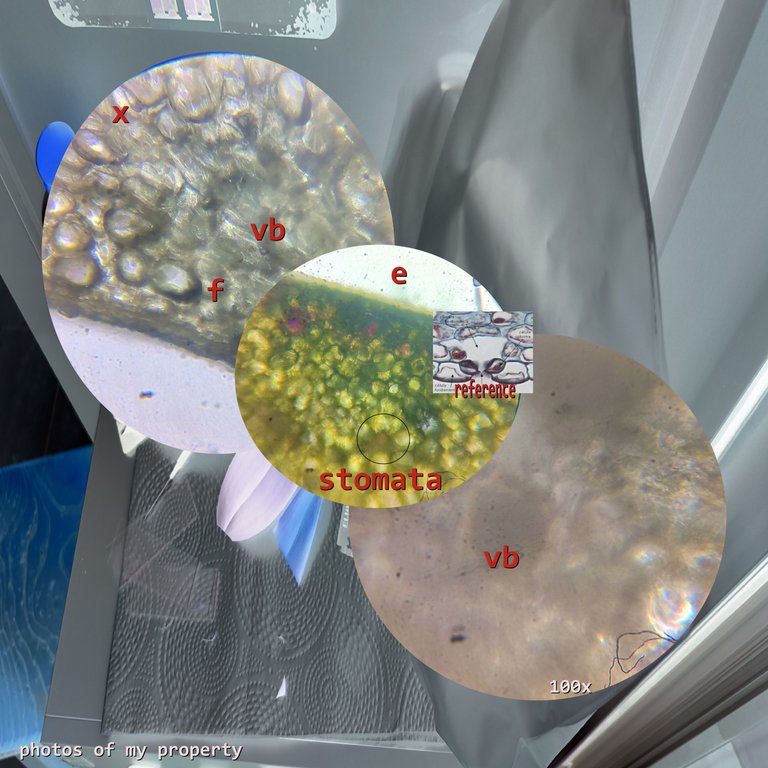
Thanks to the presence of stomata, gas and water exchange takes place in the plant. They are occlusive structures with a chamber beneath them (substomatal). Depending on the plant species, the distribution of the stomata can vary, from the epidermis on the abaxial side where there is no sun to the adaxial side in aquatic plants. I removed a leaf from my aquarium to be able to see the stomata since here submerged plants have an interesting arrangement and we find it in the mesophyll.🧑🏻🎓🥬
Gracias a la presencia de estomas se produce el intercambio gaseoso e hidrico en la planta, son estructuras oclusivas con una camara debajo de ellas (subestomatica), dependiendo de la especie de planta la distribucion de los estomas puede variar, desde la epidermis en la cara abaxial donde no hay sol hasta en la cara adaxial en plantas acuaticas, yo extraje una hoja de mi acuario para poder ver los estomas ya que aqui las plantas sumergidas tienen una disposicion interesante y la encontramos en el mesofilo.🧪🧫
https://mmegias.webs.uvigo.es/1-vegetal/v-imagenes-grandes/proteccion_estomas.php#:~:text=Los%20estomas%20son%20las,una%20cavidad%20denominada%20c%C3%A1mara%20subestom%C3%A1tica.


DNA is an organization to foster and DENSIFY NATURE-APPRECIATION which aims to establish REPORTS OF BIODIVERSITY DATA that is contributed by all of us Hiveans and subsequently cataloged.
Therefore DNA searches for HIGH-QUALITY posts that aim to DESCRIBE and determine the BIODIVERSITY AROUND YOU with added EXPLANATIONS and INFORMATION. For these informative posts they offer a CURATION SERVICE using the @dna.org account. It is also a CURATION TRAIL. Just add the #dna TAG if you think that any of your posts is what they are looking for.
THANKS FOR READING ME (PHOTOS AND VIDEOS OF MY PROPERTY) / GRACIAS POR LEERME FOTOS Y VIDEOS DE MI PROPIEDAD🙂🧠🦾👍
















Very nice presentation.
!discovery 41
thanks for support :D
Thank you for your witness vote!
Have a !BEER on me!
To Opt-Out of my witness beer program just comment STOP below
View or trade
BEER.Hey @enforcer48, here is a little bit of
BEERfrom @isnochys for you. Enjoy it!Learn how to earn FREE BEER each day by staking your
BEER.This post was shared and voted inside the discord by the curators team of discovery-it
Join our Community and follow our Curation Trail
Discovery-it is also a Witness, vote for us here
Delegate to us for passive income. Check our 80% fee-back Program
Congratulations @biologistbrito! You have completed the following achievement on the Hive blockchain And have been rewarded with New badge(s)
Your next target is to reach 110000 upvotes.
You can view your badges on your board and compare yourself to others in the Ranking
If you no longer want to receive notifications, reply to this comment with the word
STOPCheck out our last posts:
Thanks for your contribution to the STEMsocial community. Feel free to join us on discord to get to know the rest of us!
Please consider delegating to the @stemsocial account (85% of the curation rewards are returned).
You may also include @stemsocial as a beneficiary of the rewards of this post to get a stronger support.